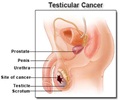According to researchers, young men are putting their lives at risk because they fail to examine their testicles for signs of tumors and are
According to researchers, young men are putting their lives at risk because they fail to examine their testicles for signs of tumors and are embarrassed to consult their general practitioner if they feel a lump. Authors from the Texas base their argument on a case study involving a young man who was involved in a car accident and suffered minor injuries.
Four days later he died of a blood clot in the lung which, following a postmortem, was discovered to be a consequence of cancer that had spread from a testicular tumor. After investigating the fatal pulmonary embolism, pathologists deduced that the testicular tumor had probably been present but undetected for months.The researchers, from Nijmegen's University Medical Centre St Radboud, warn that a treatment delay of more than three months for testicular carcinoma is associated with a (significantly decreased) five-year survival rate.
And they say that diagnostic delay is often due to patients' ignorance of the condition, fear or embarrassment. In an accompanying commentary in The Lancet, Dr Jeremy Steel, of London's St Bartholomew's Hospital, said that it was essential that medical students were trained in examination of the (external genitalia), as part of the regular examination of the abdominal system.
Some men with large testicular lumps continue to evade the medical profession despite all efforts. According to him, medical professionals and the general population, especially men, need to be educated to recognise that testicular lumps are a medical emergency.
This tragic case is a stark warning of the possible consequences of ignoring testicular abnormalities. It's vital that men and boys get any testicular firmness, swelling, lumps or discomfort checked out by their general practitioner without delay.
Such changes usually have another explanation, but if it is testicular cancer, it is almost always curable if it's found early. These days more than nine out of ten patients are cured, even if the disease has spread to other parts of the body.
Advertisement











